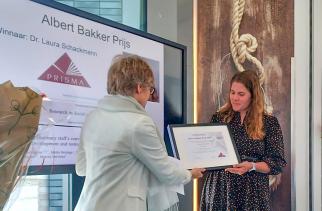Programmaleider Zorg en Participatie bij Chronische aandoeningen; bijzonder hoogleraar 'Farmaceutisch zorgonderzoek', Rijksuniversiteit Groningen
Publicatie
Publicatie datum
Facilitating pharmacy staff's conversations about non-medical medication switches: development and testing of a communication training.
Schackmann, L., Heringa, M., Wolters, M., Faber, A., Dijk, L. van, Koster, E.S., Vervloet, M. Facilitating pharmacy staff's conversations about non-medical medication switches: development and testing of a communication training. Research in Social & Administrative Pharmacy: 2023, 19(5), p.738-745.
Lees online
Background
Non-medical medication switches, a change to another medicine or medication label not motivated by medical reasons, occur frequently. Switches often lead to negative patient emotions, such as confusion and anger. Pharmacy staff's communication, i.e. delivering the message and addressing patients' emotions is crucial, but experienced as difficult.
Objective
To develop and test a communication training for the pharmacy team to facilitate medication switch conversations.
Methods
A communication training was developed based on the 'breaking bad news model' and 'positive message framing' strategies, and incorporating needs and preferences from practice. The training consisted of an e-learning with theory and reflective exercises, a half-day live training session, and an online reflection session. The Kirkpatrick training evaluation model (levels one 'reaction' and two 'learning') was used to evaluate the training. Quantitative data were analyzed using descriptive statistics and interview data was transcribed verbatim and analyzed thematically.
Results
Twelve pharmacists and 27 pharmacy technicians from 15 Dutch pharmacies participated in the training. According to Kirkpatrick's model level one, the major learning outcome was to give space to patients to express their emotions and/or concerns (e.g. more silences in the conversations). For level two, most participants valued practicing the conversations, role-playing, and receiving feedback. The majority of the participants indicated that they had sufficient tools and practice during the live training to apply the strategies in daily practice. A few participants still needed time and practice, or missed examples to apply the strategies.
Conclusion
The communication training based on the two strategies was well-received and participants felt well-equipped post-training. The take-away for participants was to give space to patients to express their emotions. Using these strategies and skills, pharmacy teams can tailor their medication counseling to patients' emotions and concerns during non-medical medication switches to better support patients in proper medication use.
Non-medical medication switches, a change to another medicine or medication label not motivated by medical reasons, occur frequently. Switches often lead to negative patient emotions, such as confusion and anger. Pharmacy staff's communication, i.e. delivering the message and addressing patients' emotions is crucial, but experienced as difficult.
Objective
To develop and test a communication training for the pharmacy team to facilitate medication switch conversations.
Methods
A communication training was developed based on the 'breaking bad news model' and 'positive message framing' strategies, and incorporating needs and preferences from practice. The training consisted of an e-learning with theory and reflective exercises, a half-day live training session, and an online reflection session. The Kirkpatrick training evaluation model (levels one 'reaction' and two 'learning') was used to evaluate the training. Quantitative data were analyzed using descriptive statistics and interview data was transcribed verbatim and analyzed thematically.
Results
Twelve pharmacists and 27 pharmacy technicians from 15 Dutch pharmacies participated in the training. According to Kirkpatrick's model level one, the major learning outcome was to give space to patients to express their emotions and/or concerns (e.g. more silences in the conversations). For level two, most participants valued practicing the conversations, role-playing, and receiving feedback. The majority of the participants indicated that they had sufficient tools and practice during the live training to apply the strategies in daily practice. A few participants still needed time and practice, or missed examples to apply the strategies.
Conclusion
The communication training based on the two strategies was well-received and participants felt well-equipped post-training. The take-away for participants was to give space to patients to express their emotions. Using these strategies and skills, pharmacy teams can tailor their medication counseling to patients' emotions and concerns during non-medical medication switches to better support patients in proper medication use.
Background
Non-medical medication switches, a change to another medicine or medication label not motivated by medical reasons, occur frequently. Switches often lead to negative patient emotions, such as confusion and anger. Pharmacy staff's communication, i.e. delivering the message and addressing patients' emotions is crucial, but experienced as difficult.
Objective
To develop and test a communication training for the pharmacy team to facilitate medication switch conversations.
Methods
A communication training was developed based on the 'breaking bad news model' and 'positive message framing' strategies, and incorporating needs and preferences from practice. The training consisted of an e-learning with theory and reflective exercises, a half-day live training session, and an online reflection session. The Kirkpatrick training evaluation model (levels one 'reaction' and two 'learning') was used to evaluate the training. Quantitative data were analyzed using descriptive statistics and interview data was transcribed verbatim and analyzed thematically.
Results
Twelve pharmacists and 27 pharmacy technicians from 15 Dutch pharmacies participated in the training. According to Kirkpatrick's model level one, the major learning outcome was to give space to patients to express their emotions and/or concerns (e.g. more silences in the conversations). For level two, most participants valued practicing the conversations, role-playing, and receiving feedback. The majority of the participants indicated that they had sufficient tools and practice during the live training to apply the strategies in daily practice. A few participants still needed time and practice, or missed examples to apply the strategies.
Conclusion
The communication training based on the two strategies was well-received and participants felt well-equipped post-training. The take-away for participants was to give space to patients to express their emotions. Using these strategies and skills, pharmacy teams can tailor their medication counseling to patients' emotions and concerns during non-medical medication switches to better support patients in proper medication use.
Non-medical medication switches, a change to another medicine or medication label not motivated by medical reasons, occur frequently. Switches often lead to negative patient emotions, such as confusion and anger. Pharmacy staff's communication, i.e. delivering the message and addressing patients' emotions is crucial, but experienced as difficult.
Objective
To develop and test a communication training for the pharmacy team to facilitate medication switch conversations.
Methods
A communication training was developed based on the 'breaking bad news model' and 'positive message framing' strategies, and incorporating needs and preferences from practice. The training consisted of an e-learning with theory and reflective exercises, a half-day live training session, and an online reflection session. The Kirkpatrick training evaluation model (levels one 'reaction' and two 'learning') was used to evaluate the training. Quantitative data were analyzed using descriptive statistics and interview data was transcribed verbatim and analyzed thematically.
Results
Twelve pharmacists and 27 pharmacy technicians from 15 Dutch pharmacies participated in the training. According to Kirkpatrick's model level one, the major learning outcome was to give space to patients to express their emotions and/or concerns (e.g. more silences in the conversations). For level two, most participants valued practicing the conversations, role-playing, and receiving feedback. The majority of the participants indicated that they had sufficient tools and practice during the live training to apply the strategies in daily practice. A few participants still needed time and practice, or missed examples to apply the strategies.
Conclusion
The communication training based on the two strategies was well-received and participants felt well-equipped post-training. The take-away for participants was to give space to patients to express their emotions. Using these strategies and skills, pharmacy teams can tailor their medication counseling to patients' emotions and concerns during non-medical medication switches to better support patients in proper medication use.



